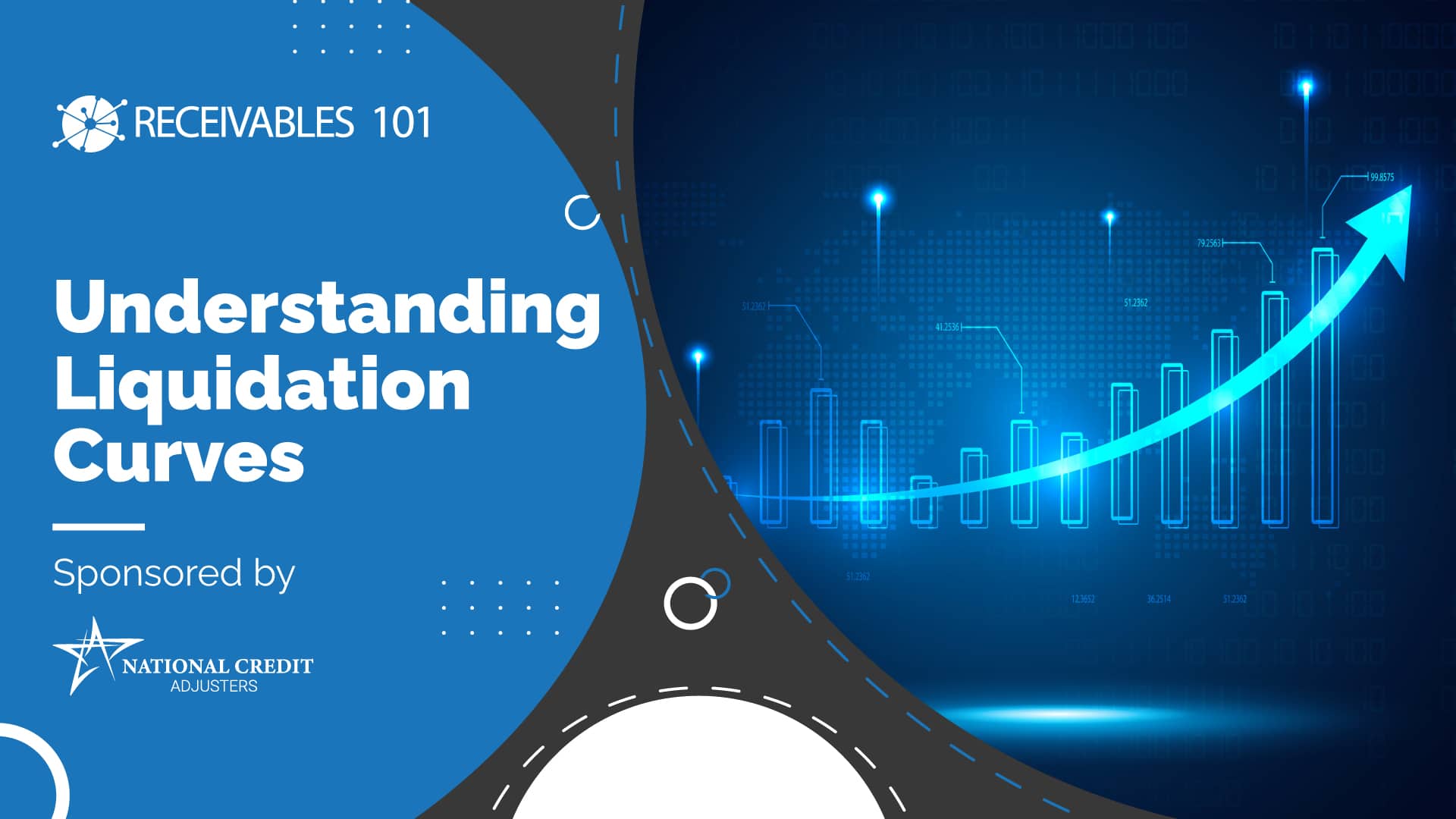
Understanding Liquidation Curves
Understanding liquidation curves in account receivables can be like piecing together a complex puzzle—filled with ever-evolving patterns and variables. In this blog, we’ll embark on a journey to unravel this complex topic, from the fundamentals of receivables investing to the intricate dance of liquidation curves in today’s shifting financial landscape.
Informed by insights from industry expert Mark Naiman, we’ll explore how you can contribute to your company’s success, regardless of your role. We’ll delve into the strategies to create efficiencies, reduce costs, and enhance returns—offering you a guide to navigating your professional growth in the world of receivables.
What are liquidation curves in accounts receivables?
A liquidation curve is a graphical illustration that provides an overview of how much and when an investment in a portfolio of receivables is expected to yield returns. It plots time on the X-axis against the cumulative percentage of recoveries on the Y-axis, providing a roadmap of the expected return on investment over time.
However, like a heartbeat, the liquidation curve is far from static. It varies with changes in market dynamics, responding to various external stimuli, and providing a real-time pulse of a receivables investment.
How to navigate the evolution of liquidation curves
Liquidation curve models in the receivables management industry have seen significant evolution over the years, driven by factors such as the rising cost of receivables, changes in legislation, fluctuations in supply and demand, and the increasing pressure of consumer inflation. These elements have combined to elongate the liquidation curve, reflecting a more extended recovery period for investments compared to a decade ago.
To understand this evolution better, we turn to the insights shared by Mark Naiman, an industry veteran who has witnessed this transformation first-hand. Naiman recalls the liquidation curves in the early 2000s were based on a 2 or 3-year timeline, reflecting the expectation of recovery from fresh credit card products.
As we approached the mortgage broker collapse in 2008, however, the perspective shifted. Receivables were sold for higher prices, leading to the extension of the liquidation curve to a 5-7 year span by 2010.
By 2013-14, in response to the strengthening of regulations and other market changes, public companies started to employ 12-year liquidation curves. Today, it’s not uncommon to see liquidation curves spanning over a decade, a testament to the ever-evolving nature of our industry.
What’s the waterfall effect in streamlining collections?
Liquidation curves and collection strategies share a symbiotic relationship—each influence and is influenced by the other. A pivotal strategy that takes center stage in this dance is the ‘waterfall collection process.’ This process is akin to a well-orchestrated performance, where every act is meticulously planned and executed to ensure a flawless show.
The waterfall collection process operates on a fundamental principle: prioritize and execute collection strategies based on their effectiveness. Imagine you’re at the top of a waterfall—the point where the water (or in our case, the potential recovery from a portfolio) is at its fullest. At this stage, you’d employ the most effective, typically the least costly, strategies to collect from your accounts. This is akin to gently skimming the surface, capitalizing on the low-hanging fruit.
As you journey down the waterfall, the water’s volume decreases, mirroring the diminishing returns from the accounts. Here, the strategies may require more effort and resources, reflecting the increased force needed to extract the remaining water. This could involve more intensive collection efforts, specialized agencies, or even legal action. Despite the higher costs, these strategies are necessary to ensure maximum recovery.
The artistry of managing the waterfall collection process is not just in choosing the right strategies—it’s about knowing when to cascade from one to the next. It’s about striking a balance between maximizing recovery from each stage while minimizing the time and resources expended.
In this context, your role becomes incredibly significant. Whether you’re on the front line dealing with the accounts or behind the scenes analyzing performance, your actions influence the effectiveness of the waterfall process, and by extension, the shape of the liquidation curve.
By constantly looking for ways to improve the process—be it through better account segmentation, quicker response times, or enhanced analytics—you can contribute to making the waterfall flow more efficiently and profitably. This, in turn, can help your organization achieve a more advantageous liquidation curve.
How can you influence the liquidation curve?
You might wonder, what part can I play in this grand scheme of things? The truth is, irrespective of your position, you hold the power to positively influence the liquidation curve. Here’s how:
- Strive for greater efficiency: Look at the accounts you’re handling with an eagle eye. Could something be done faster? Better? Your ability to drive efficiency, from the smallest task to broader operational strategies, directly shapes the liquidation curve. The result? A more profitable trajectory that reflects your dedication to excellence.
- Embrace the tech revolution: Advanced technologies such as AI and intricate software applications aren’t just buzzwords—they’re tools to elevate your work. Familiarize yourself with them, learn their strengths, and consider how they can improve your day-to-day tasks. With these tech allies, you can uncover promising accounts more effectively, streamline collection strategies, and drive up the liquidation curve.
- Build an informed mindset: Knowledge isn’t power—it’s empowering. As you understand your organization’s strategies and their impact on the liquidation curve, your role becomes clearer, and your contributions become more meaningful. You’re not just doing a job; you’re part of a team, working together to shape the overall shared success.
- Keep curiosity alive: Curiosity didn’t just get us to Mars—it can elevate your career. Stay hungry for knowledge, open to new methods, and committed to learning. By doing so, you’re not just adding value to your role; you’re opening new doors and possibilities for your professional growth.
A Vision for the Future: The Path to Mastery
As you progress on your professional journey, remember that the landscape of receivables investing continually evolves. The liquidation curves we see today may differ from those we’ll navigate tomorrow. By understanding the complexities of liquidation curves and applying this knowledge to improve efficiencies and reduce costs, you can play a significant role in shaping the future of your organization and the industry.
Ultimately, remember you’re an integral part of the receivables management ecosystem. Every decision you make, every innovation you introduce, and every efficiency you create can have a ripple effect, influencing the shape of the liquidation curve, and thus, the profitability of the business.
By mastering liquidation curves, you are not just enhancing your own value and shaping your career trajectory; you’re also contributing to a bigger cause—shaping the future of the receivables investing industry. Let your journey be the inspiration for others and the testament to the endless possibilities that knowledge, curiosity, and commitment can unlock.
The information contained in this article and the Receivables 101 series is meant to serve as general guidance for mid-level ARM industry professionals and is not meant to serve as comprehensive business, legal, or financial advice.
Would you like to sponsor an article or suggest a topic? Email [email protected].
Thank you to our sponsor, National Credit Adjusters, LLC
National Credit Adjusters, a privately held company, has specialized in purchasing and servicing delinquent account receivables since 2002. Their primary area of acquisition is consumer installment and online lending. NCA stays current on industry standards through ongoing research, automation, analytics, and process evaluation. National Credit Adjusters focuses on strong performance while adhering to compliance standards through constant quality training and employee development. Whether purchasing, servicing, or selling debt, NCA conducts all business with respect and fairness. For more information, visit ncaks.com.









